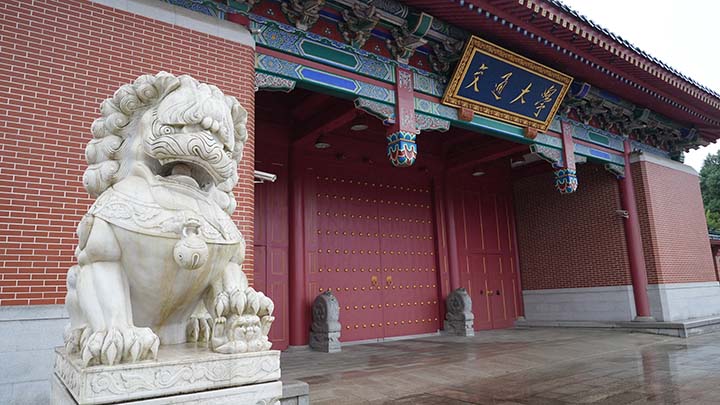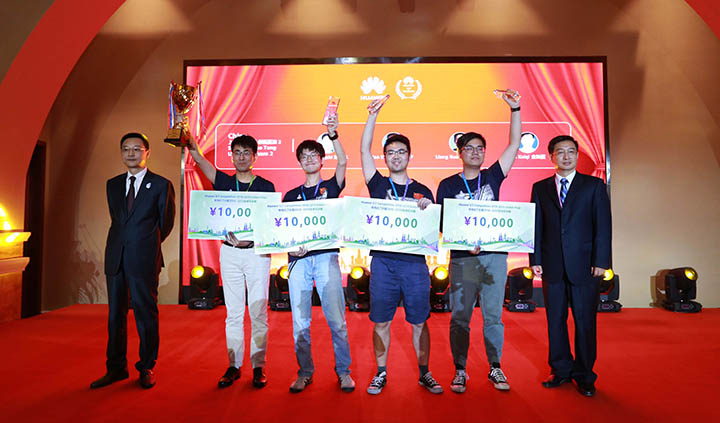How Shanghai Jiao Tong University Built a Training Model
This site uses cookies. By continuing to browse the site you are agreeing to our use of cookies. Read our privacy policy>
![]()
Enterprise products, solutions & services

Reading guide: Shanghai Jiao Tong University and Huawei have worked together to develop a training model that has reformed the university's course content and teaching methods, supported and encouraged its students to pursue entrepreneurship, and set an example for mutually beneficial collaboration between universities and enterprises.
It's been almost five years since Shanghai Jiao Tong University and Huawei began collaborating on projects that link enterprises and education institutions. In 2017, Shanghai Jiao Tong University (SJTU) and Huawei signed an agreement to establish the Huawei ICT Academy Innovation Talent Center. The two parties devised a "Course-Competition-Innovation" training model that has enabled many students to learn more about digital technologies; it entails integrating Huawei technologies into the university's courses, holding Information and Communications Technology (ICT) competitions, and facilitating students' innovation and entrepreneurship.
To develop the innovation and entrepreneurship demonstration center and train more students in innovative techniques and ways of thinking, SJTU rebuilt the Engineering Training Center (which was essentially a facility for students to practice their engineering skills) in 2016 and turned it into a Student Innovation Center, which offered additional functions such as the business start-up guide.
While operating the Student Innovation Center, the university found several problems with the existing talent development model: The training objectives lacked foresight and were not customized according to different needs, there was a disconnect between what was being taught and what the industry needed, and the center lacked advanced technical platforms to support teaching activities. To solve these problems, the university and the industry must collaborate.
As a leading global provider of Information and Communications Technology (ICT) infrastructure and smart devices, Huawei is training ICT talent for colleges and universities through collaborative projects. Driven by shared goals and complementing each other's respective strengths, SJTU and Huawei are working together to train students.
In recent years, emerging digital technologies — such as cloud computing and big data — are becoming increasingly influential. In this context, how can we support students to learn these cutting-edge technologies and achieve their innovation and entrepreneurship aspirations?
We have partnered with Huawei to develop a series of innovation training courses focused on cutting-edge technologies — such as Internet of Things (IoT), Artificial Intelligence (AI), and HarmonyOS, including learning LiteOS + Narrowband Internet of Things (NB-IoT) with ease, IoT engineering practice, open class for Huawei Certified ICT Associate-AI (HCIA-AI), big data courses for the top five universities in East China, a training camp based on simulation of Huawei autonomous driving, Huawei Cloud ModelArts, cybersecurity practice, and HarmonyOS innovation training camp. We have delivered each of these courses more than 30 times, training more than 2000 students.
For example, the HCIA-AI open class held in 2018 attracted more than 400 students from a diverse range of departments and majors, including mechanical engineering, electronic information, naval architecture, material science and engineering, and economics management; many teachers were also very enthusiastic about the course. Learning knowledge that extends beyond the scope of the subjects they have chosen as their majors, broadens students' horizons, and helps them build a more complete knowledge system, which gives them the building blocks for more innovative thinking.
Unlike traditional theoretical teaching, these new courses focus on real-scenario application development based on project programming, improving students' practical capabilities and enabling them to independently develop their own projects for evaluation, oral defense, examinations, and competitions. As well as helping students master new technologies, this model of learning and practicing also inspires their creativity.
Through cooperating with Huawei and reforming our teaching models, we have trained many students. Our achievements have been recognized by the university and won several national awards. For example, the innovative education model featuring resource-sharing, cross-subject teaching, university-enterprise cooperation, and promoting learning and innovation developed by the Student Innovation Center was presented with the Grand Prize of the SJTU Teaching Achievement Award in 2019. The Algorithms and Practices of Deep Learning course won the Grand Prize in the Second National Blending Learning Design and Innovation Competition.

Shanghai Jiao Tong University students celebrate winning the first prize in the Innovation Track of the 4th Huawei ICT Competition Global Final
Science and technology competitions are an effective way to help students improve their practical skills. We encourage students to apply the knowledge they learned in class to practice, and design products and solutions based on market demand for various competitions. This approach can inspire students to become passionate about innovation and help them to improve their skills.
Since 2018, SJTU has participated in the Innovation Competition of Huawei ICT Competition for four consecutive years, and its team won first place in the Innovation Track of both the 4th and the 5th Huawei ICT Competition Global Finals. In the 5th Huawei ICT Competition, graduate students from the School of Mechanical Engineering developed an intelligent driving platform centered on device-cloud synergy. This impressive platform used algorithms such as image augmentation, GMapping, and Adaptive Monte Carlo Localization (AMCL) to fulfill functions such as traffic light recognition, car speed limit and speed limit cancellation, cross walk recognition and pedestrian avoidance, lane line and intersection driving, and automatic parking.
In the National IoT Design Competition of 2018, the team from SJTU won first prize for its intelligent library seat reservation system and for its NB-IoT-based Automated External Defibrillator (AED) intelligent management system. The former also won the Special Innovation Award from Huawei.
Learning digital technologies and participating in various competitions are new ways for students to develop their skills, while innovation and entrepreneurship can accelerate the development of life-changing technologies. In response to the national initiative of College Students' Innovation and Entrepreneurship Training Program that China's Ministry of Education launched, the Student Innovation Center has enabled our students to achieve even more. We have guided students' innovation in research programs and projects and encouraged students to apply what they have learned to working in the industry and even to start their own businesses.
Crucially, we have achieved meaningful results. For example, four graduate students from the School of Mechanical Engineering and the School of Electronic Information and Electronic Engineering used cloud and AI technologies to develop a Huawei Cloud-based virtual live broadcast service platform. The advanced AI vision algorithm makes virtual live broadcasts much easier, enabling e-commerce companies to better integrate virtual reality into live broadcasts, allowing real audiences to interact with virtual anchors, and making the live broadcasts more entertaining. In 2019, the team submitted the product to the 4th Huawei ICT Competition, winning first prize in the Innovation Track. Based on this technology, they set up a company named VOKA, which has already gained funding and investment, and they are currently optimizing the product before rolling it out to the market. This is a prime example of applying knowledge learned from the course to contribute to social progress.
Our goal is to train innovation-oriented talent in the university and inspire more young people to learn and innovate technologies. Since 2019, the Student Innovation Center and Huawei have jointly held two editions of the Automated Driving Cup, an AI technology-featuring competition for outstanding middle school students across the country. The event aims to link basic education with higher education to help train AI specialists.
The cooperation between the university and Huawei has reformed course content, supported students' entrepreneurship, and set an example of mutually beneficial cooperation between universities and enterprises. This model has been widely recognized by universities and enterprises nationwide, and has been successfully replicated in Harbin Institute of Technology and Tianjin University.
We will deepen our partnership with Huawei to train more innovative ICT specialists by focusing on cutting-edge technologies such as AI and HarmonyOS, contributing to China's ambitious plan to become a global ICT powerhouse.